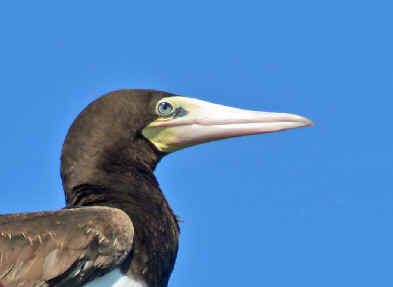The BIRDLINE, by ARMAS HILL
With a Booby on its way, a Yellowthroat the wrong way, and more
Armas Hill has presented the "Birdline", originally from
Philadelphia, on the phone and internet for over 3 decades, and on the radio
in Delaware for about 10 years.
Links:
A
List & Photo Gallery of North American Birds, in 6 Parts
A
List & Photo Gallery of North American Mammals


The Brown Booby that left
Cape May
as November was about to begin
(photo by Howard Eskin)
The Birdline
for November 4, 2011:
November came this week, and the
long-staying BROWN BOOBY near Cape May, New
Jersey, left.
It did so the morning of the last day of October, flying,
with determination, out the inlet toward the Atlantic Ocean
and then hopefully south to the Caribbean. The bird had been
there, at the Jarvis Sound, near Cape May, since August 20.
November came this week, and so have the first CAVE SWALLOWS
into the northeast US.
On November 1, at the Allegheny Front Hawkwatch, along the
Somerset/Bedford County border in southern Pennsylvania,
a single CAVE SWALLOW was seen, as were the 61 GOLDEN EAGLES
that passed by that hawkwatch that day.
CAVE SWALLOWS have also been seen lately in New
Jersey, at Cape May, and in North Carolina.
Last time here, we mentioned 9 GOLDEN EAGLES in 2 hours at
the Franklin Mountain Hawk Watch in Oneonta, New
York. 31 GOLDEN EAGLES passed by there on October
30.
That same day, also in upstate New York, a YELLOW-BILLED
LOON was seen in flight over Lake Ontario, at Walcott.
The YELLOWTHROAT referred to in the title was a COMMON
YELLOWTHROAT that was, last week, in Iceland.
More about that and other North American birds there, later,
but first a note here, followed by some other bird news:
This week a FONT e-mail was sent out relating to a
series of illustrations of 50 Bird Beaks mostly
unusual, as a quiz. So far, 36 people have
participated in the quiz. If you did not receive that
e-mail, and would like to take a peek at the beaks,
click this link: http://www.focusonnature.com/BeaksPhotoFeature.htm
A HARRIS'S SPARROW has been present this week at Sandy Hook,
New Jersey. The species comes to the US,
but mostly in the Central US, in the winter.
Don't ever look for a HARRIS'S SPARROW NEST in the summer in
the United States. The species is one of the very few North
American birds that doesn't breed anywhere in the US.
Only Canada.
A bird from the western US was in Cape May NJ this
week: a WHITE-WINGED DOVE on November 2.
Another westerner was in Maryland this
week, a GOLDEN-CROWNED SPARROW on November 1, east of
Annapolis. As was another, a CALLIOPE HUMMINGBIRD in eastern
Maryland.
In Massachusetts, an ASH-THROATED
FLYCATCHER, from the West, was seen last weekend at the
Parker River National Wildlife Refuge.
Also in Massachusetts, a SCISSOR-TAILED FLYCATCHER has
continued on Nantucket Island, and a TUFTED DUCK has
continued in Attleboro.
SELASPHORUS (probably RUFOUS) HUMMINGBIRDS, from the West,
have been this week in western Pennsylvania,
in Allegheny County, and in Maryland, in
Cecil County, with the latter from November 1 to the am of
November 3, not since.
Mostly-western birds that have been seen at various places
in the East, this week, have been ORANGE-CROWNED WARBLERS
and CLAY-COLORED SPARROWS.
Both species were reported in the city of Philadelphia
on October 31, in a weedy area by the Delaware River.
Elsewhere in Pennsylvania, an
ORANGE-CROWNED WARBLER was at Woods Edge Park in
Lancaster on November 1.
A WESTERN KINGBIRD was found at Cape May Point, New
Jersey, today, November 4.
At Cape May, in the afternoon on Sunday, October
30, a total of 21 AMERICAN BITTERNS were
counted as they rose up out of "the Meadow",
where that day a BLACK RAIL was flushed. Later, one was
seen, and still later, at the end of the day, one was
heard.
Last time, we noted that at a field in Lehigh County, Pennsylvania,
there were, on October 27, over 125 AMERICAN PIPITS.
That same field was visited on November 1, and that day only
2 PIPITS were found, but there were up to 50 HORNED LARKS,
and 2 SNOW BUNTINGS. Winter is coming! A SNOWY OWL has
appeared in southern Maine.
Most of us know about the remarkable expansion, during the
last century, of the CATTLE EGRET. It was unknown in North
America prior to 1952.
The species is said to have come on its own from western
Africa to northeastern South America,
back in the 1870s and 1880s. Not only has it come
north, it has also gone south. The first records in Tierra
del Fuego, at the southern tip of
South America, were in the fall of 1975. It has
also wandered, on its own, to the Falkland
Islands and even South Georgia Island.
The southernmost record is from the Antarctic
Peninsula at 65 degrees south.
The CATTLE EGRET is in a rather exclusive club, having occurred
on all the world's continents.
In Europe, the CATTLE EGRET occurs commonly
only in Spain. But it has also gone as
far north, now, on its own, as Iceland!
This week, on November 1, the fifth CATTLE EGRET
ever to occur in Iceland, met its demise
there in the southeastern part of the country. It was eaten
by a GYRFALCON.
However, that same day, the sixth CATTLE EGRET ever to occur
in Iceland appeared, also in the southeast.
Iceland is one of the best places in the
world for vagrant birds, especially in the spring and fall.
In all, about 380 species of birds have occurred there. The
vagrants come both from the east, from mainland
Europe, and from the west, from North
America.
The assortment of birds from North America
that have been noted in Iceland, during the
past 3 months (August, September, October) included
the COMMON YELLOWTHROAT that was mentioned at the beginning
of this text. That little bird from America was found
on October 26 in southwest Iceland and was seen through
October 29. It was the 3rd record for the species in Iceland.
Other American species in Iceland, in
recent weeks, going back to August, have been:
2 drake AMERICAN WIGEONS on September 24, 25, October 7, 14,
18, 21 & 22, 1 on September 2, 9, 11,
16, 21, 23, October 1
2 RING-BILLED GULLS on September 27, 28, October 4,
7, 10 & 22, one on October 1, 2, 13
a drake WHITE-WINGED SCOTER on October 16
AMERICAN GOLDEN PLOVERS on August 23, September 9, 16, 22,
24, 25, 26, 27, 29, 30, October 1, 2, 3, 4, 8, 9, 11
a single PACIFIC GOLDEN PLOVER on September 30, October 1, 2
(a first record for Iceland)
AMERICAN PIPITS on September 26, October 1, 2, 3, 4, 7
SNOW GOOSE on September 15, 16, 22, 24, 25, 26, October 1,
2, 3
a blue-morph SNOW GOOSE on October 7
RED-EYED VIREOS, 2 on September 21 & 23, 1 on September
20, October 3
LONG-BILLED DOWITCHERS on September 17, 18, 19, 20, 21, 22,
25, 27, 28, 29, October 1, 2, 3 (in all, there were 3
LONG-BILLED DOWITCHERS, the 8th, 9th, and 10th records for Iceland)
PECTORAL SANDPIPERS on September 3, 25, 29, 30, October 1,
2, 3
BUFF-BREASTED SANDPIPERS, 3 on September
24, 2 on October 1, 1 on
September 1, October 3
BLUE-WINGED TEALS on September 20, 21, 22, 24, 25, 26,
October 1, 2, 3
a NORTHERN PARULA on September 19 & 20 (the 8th
record for Iceland, and the first found
there since 1989)
a SEMIPALMATED SANDPIPER on August 29, 30, 31,
September 6, 7, 17 (the 7th record for Iceland)
LESSER YELLOWLEGS on September 4, 6, 10, 11, 12, 13
a RING-NECKED DUCK on September 11
a WHITE-RUMPED SANDPIPER on September 6, 7
a WILSON'S PHALAROPE on September 5 (the 5th record for
Iceland)
a SOLITARY SANDPIPER on September 4 (the 5th record for
Iceland)
a PIED-BILLED GREBE on August 2 (the 3rd record for Iceland)
As noted, a large number of vagrant birds also go to
Iceland from mainland Europe. Among those that did this
fall, these:
With just a few of the more-notables mentioned here.
A DUSKY WARBLER found on October 28 was a first record for
Iceland. (The species is from Asia.)
A BLYTH'S REED WARBLER found on September 18 was the 7th
record for Iceland. (The species is from Russia).
A juvenile PALLID HARRIER that was in Iceland September
14-17 was the first record for Iceland.
A juvenile MONTAGU'S HARRIER that was in Iceland August
24 was the 4th record for Iceland.
An ALPINE SWIFT found on August 3 was the 4th record for
Iceland.
Both a EURASIAN HOBBY and a WHITE-WINGED TERN were seen in
Iceland on August 8.
And EURASIAN COLLARED DOVES have made their way to Iceland,
on their own, from mainland Europe, with a few occurrences
this fall.
But maybe the most unexpected avian visitor to Iceland
this fall was a juvenile LITTLE BITTERN that was found on
October 16. It was the first live record for Iceland. The
only previous record was a bird found washed ashore in
May 1823!
To see a list of all the 380 or so birds that have occurred
in Iceland, click: http://www.focusonnature.com/IcelandBirdListIceland.htm
The list in that link, in the FONT website, is
probably the most complete and informative listing of
Icelandic birds, outside of Iceland.
FONT schedules tours to Iceland twice a year, in June
& in September/October.
The two HARRIERS just-noted as being in Iceland notwithstanding,
we often hear that RAPTORS are reluctant to cross extensive
bodies of water. Following, now, is an updated report about
OSPREY having done so during their non-breeding
time in the Caribbean and in South
America.
In a Birdline, just over a month ago, we told of
OSPREYS being tracked by transmitting devices
during their migration south to the Caribbean and Central
and South America.
The project is being done by Rob Bierregaard, Jr. of the
Biology Department of the University of North Carolina in
Charlotte.
Anyway, since our last report, the news about those OSPREY
has not been good. And especially during
the last couple weeks when, very unfortunately, 4
of the 8 migrating birds were lost.
Two of the OSPREY, a juvenile from New
Hampshire and an adult male from Martha's
Vineyard, Massachusetts, went down over the
Caribbean.
A juvenile from Martha's Vineyard safely
crossed the Caribbean, to the shore of the Gulf of
Venezuela, where another OSPREY in the tracking program has
spent a lot of time. But then, that Martha's Vineyard
juvenile started moving inland and "stopped" in
the middle of nowhere. She might have lost the transmitter.
But maybe not.
In the United States, an adult male from southeast
Massachusetts "stopped" moving in Florida
just east of Orlando. He was flying south at 4pm on October
23 when he "apparently fell out of the sky".
He had been cruising at about 25 miles per hour. About
an hour later, the next location was in a cattle pasture
about 3 miles from the 4pm location. Beyond that, the
story is yet unknown.
The other OSPREY that are still being tracked include:
one seemingly safely nestled in the mountains of Colombia,
another, maybe "enjoying Caribbean
life", on the cape, Cabo Beata, in the
Dominican Republic, after two aborted attempts to travel
further over the sea,
and another that also settled down in the Dominican
Republic.
These are in addition to two that have already been in Amazonian
Brazil, where they seem to be doing fine.
And let's end now, on that, a good note.
Armas Hill has presented the Birdline,
originally from Philadelphia, on the phone and the internet
for decades (3), and on the radio in Delaware for years
(10).
The Birdline (and the Natureline)
are affiliates of Focus On Nature Tours:
www.focusonnature.com
To
Top of Page


